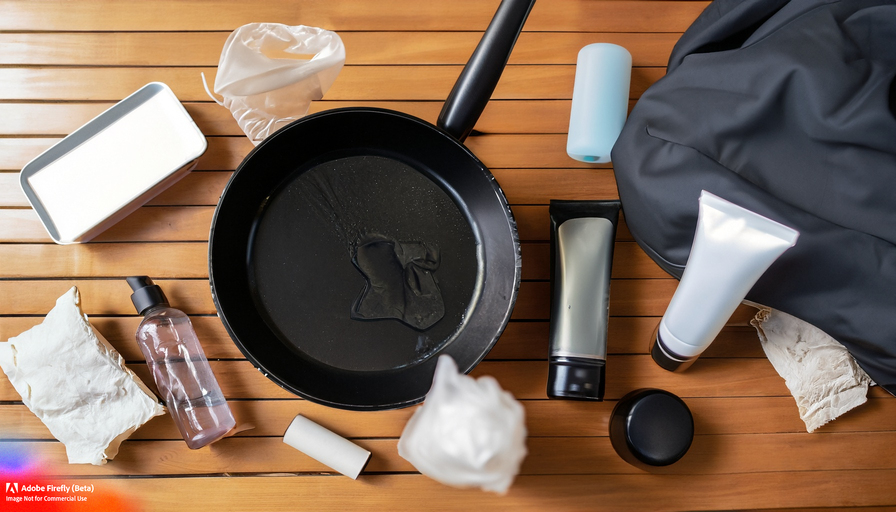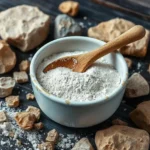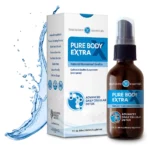How To Detoxify from PFAS: The Hidden Chemicals That Harm Your Health
Do you know what PFAS are and how they affect your health? PFAS are man-made chemicals found in many everyday products, such as nonstick pans, food wraps, and waterproof clothing.
PFASs were first created in the 1930s and were initially considered miracle material. They were initially considered non-toxic, they were non-flammable, and very stable. This made them ideal for a variety of applications and their use grew rapidly. They are known, among other things, for their water and stain-repellent properties.
However, in recent years, concerns have been raised about the effects of PFAS on our bodies. Studies have shown that they can cause several health problems, including cancer, hormonal and reproductive problems, and damage to the immune system. In this article we explain what they are, how they harm you, and how to detoxify yourself from PFAS: the hidden chemicals that damage your health.
Este artículo también está disponible en Español
What are PFAS and where are they found?
PFAS are synthetic chemicals used to make products resistant to water, oil, heat, and stains. PFAS stands for Per-and PolyFluorinated Substances, which are a family of thousands of compounds that share a similar chemical structure.
Scientists have discovered that PFAS never degrades or breaks down. That is why they are called “forever chemicals”. This means that once PFAS enter the environment, they persist virtually forever.
Some of the best-known PFASs are PFOA (perfluorooctanoic acid) and PFOS (perfluorooctanesulfonic acid), which have been widely used in industry and consumption since the 1940s.
PFAS are found in many products that we use every day, such as:
- Non-stick pans and cookware. For example, Teflon is the trade name for a chemical coating called polytetrafluoroethylene (PTFE), which belongs to the PFAS family. Teflon has been replaced by a new product called GenX, which is another type of PFAS.
- Food wrappers and containers. For example, Zonyl is the trade name for a series of products used to make food containers resistant to oil and water. Zonyl has been replaced by Capstone, which is another type of PFAS. These products contain PFOA (perfluorooctanoic acid) or related substances.
- Waterproof clothing, footwear, and accessories. For example, Gore-Tex is the trade name for a waterproof and breathable fabric used in sports and mountain clothing. These fabrics contain PTFE, the same type of PFAS as Teflon.
- Cosmetics and personal hygiene products. For example, creams, makeup, shampoos, toothpaste, or deodorants may contain PFAS to improve their texture, duration, or resistance to water.
- Cleaning and home care products. For example, detergents, cleaners, polishes, or air fresheners may contain PFAS to improve their effectiveness, aroma, or appearance.
- Fire-fighting foams. For example, aqueous film-forming foams (AFFF) are used to extinguish fires involving flammable liquids. These foams contain PFOS (perfluorooctanesulfonic acid) or related substances that give them water and oil-repellent properties.
- Industrial and aerospace lubricants. For example, Krytox is the trade name of a series of lubricants used for industrial and aerospace applications. These lubricants contain PFPE (perfluoropolyether), a type of PFAS with an ether group instead of an alkyl group.
- Membranes for fuel cells and electrolyzers. For example, Nafion is the trade name of a polymer used to manufacture membranes for fuel cells and electrolyzers. This polymer contains PFSA (perfluoro sulfonic acid), a type of PFAS with a sulfonic group instead of a carboxylic group.
- Clothing, footwear, furniture, and carpets. For example, Scotchgard is the trade name of a waterproofing product used to protect clothing, footwear, furniture, and carpets from stains and moisture. The original product contained PFOS, but it was reformulated in 2000 to use another type of PFAS.
Once PFAS get into the environment, they can easily enter the food chain, contaminating drinking water, soil, and air. Then they can enter our bodies through ingestion, inhalation, or skin absorption. Some scientific studies have shown that exposure to some PFASs in the environment may be associated with harmful effects on human and animal health.
How PFAS affect your Health

As persistent chemicals, PFAS can remain in the body for years or even decades and can interfere with the normal functioning of hormones, the immune system, metabolism, and DNA, among other systems. High levels of fluorinated compounds (like PFAS) have been linked to cancer, hormone disruption, among other health problems.
Some of the negative effects that PFAS can have on our health according to various studies are:
- Cancer: exposure to PFAS can alter the cellular balance and favor the abnormal growth of tumors in different organs. Some of the most common and serious cancers that have been linked to PFASs include kidney, testicular, prostate, breast, and thyroid cancers. 3. A recent study (2013) found that individuals from a community exposed to PFAS in drinking water was associated with increased risk of thyroid disease, kidney cancer, testicular cancer, and other diseases.
- Hormonal problems: PFAS can interfere with the production and function of hormones that regulate reproduction and sexual development. This can lead to difficulties conceiving, inflammatory diseases of the uterus, ovarian cysts, early menopause, sexual impotence, and low sperm quality.
- Obesity and diabetes: PFASs can alter the function of cells that burn fat and sugar, causing them to accumulate in the body. This can lead to excess weight, decreased insulin sensitivity, and a higher chance of developing type 2 diabetes.
- Immune problems: PFAS can interfere with the development and function of immune cells that protect us from pathogens. This can decrease the inflammatory response, antibody production, and immunological memory. As a result, we can suffer more infections and diseases caused by viruses, bacteria, and parasites that invade us.
- Immune problems: PFAS can interfere with the development and function of immune cells that protect us from pathogens. This can decrease the inflammatory response, antibody production, and immunological memory. As a result, we can suffer more infections and diseases caused by viruses, bacteria, and parasites that invade us.
- Liver problems: PFAS can affect the organ responsible for filtering and eliminating toxins from the body. This can cause the liver to become inflamed, hard, or scarred, and lose its ability to function properly.
- Cardiovascular problems: PFAS can alter the function of the heart and blood vessels. This can make blood flow more difficult and fatty plaques build up in the arteries. As a consequence, we can have higher blood pressure, a high cholesterol level, and a greater probability of suffering heart attacks or cerebrovascular accidents.
- Neurological problems: PFAS can interfere with the growth and maturation of the brain. This can affect people’s cognitive, emotional, and behavioral abilities. Some of the problems that have been linked to PFAS are attention deficit hyperactivity disorder (ADHD), autism spectrum disorder (ASD), and cognitive impairment.
How to reduce your exposure to PFAS

The best way to prevent the harmful effects of PFASs is to avoid or reduce our exposure to these chemicals. Although it is impossible to eliminate our exposure to PFASs, there are some steps we can take to minimize it:
- Avoid using non-stick pans and kitchen utensils and opt for more natural materials such as iron or ceramic.
- Prefer fresh and organic foods instead of processed or packaged. Avoid consuming food that comes in wrappers or containers with non-stick or waterproof coatings.
- Wash and disinfect fruits and vegetables well before consuming them. Peel them if possible.
- Use water filters or buy bottled water in glass containers. Avoid reusing plastic bottles that may contain these chemicals.
- Choose personal hygiene and cleaning products without these compounds. Read labels and ingredients carefully. Look for certified organic or natural products.
- Avoid wearing waterproof clothing, footwear, and accessories that may contain these chemicals. Wash them before first use.
- Avoid using fire-fighting foams that contain any form of PFAS. Look for safer alternatives.
- Avoid using paints, varnishes, and waxes that contain these chemicals. Ventilate rooms well after painting or varnishing.
How to remove PFAS from your body

Once PFAS enter our bodies, they can accumulate in organs such as the lungs, liver, and bones. Some PFAS particles leave the body slowly over time, mainly filtered by the kidneys and eliminated through the urine. However, it is estimated that they can remain in the body for up to four years or more before being eliminated.
Unfortunately, there isn’t much scientific evidence to support any effective method of detoxifying the body from PFAS. However, although the studies are limited, some evidence shows that Zeolite can absorb PFAS dissolved in aqueous solutions, so it could be a safe and simple way to reduce the presence of PFAS in our bodies.
Read our Related Post:
How Zeolite Can Detoxify Your Body and Boost Your Health
Discover the health benefits of zeolite: detoxify, balance, and boost wellness naturally. Transform your health with this powerful mineral. Read more about how zeolite can improve your health by removing toxins from your body.
There is also some evidence that Activated Carbon can remove some types of PFAS from drinking water, however there are not known studies that shows if it can help to remove PFAS from our bodies.
Studies are required to focus on finding results of the detoxifying effect of elements such as activated carbon and zeolite with respect to PFAS in our body. In the meantime, the best way to stay away from the adverse effects of PFASs is to avoid exposure to them, as we explained in the previous section, and keep our detoxification system working in optimal conditions.
We can help our bodies through diet or supplementation. Some foods or supplements that can help us are:
- Foods rich in fiber: fiber helps cleanse the intestine and facilitates the elimination of toxins through feces. Some fiber-rich foods are fruits, vegetables, whole grains, legumes, seeds, and nuts.
- Foods rich in antioxidants: antioxidants help protect cells from damage caused by free radicals generated by toxins. Some foods rich in antioxidants are berries, green tea, dark chocolate, tomato, broccoli, and spices such as turmeric or ginger.
- Foods rich in probiotics: probiotics are beneficial bacteria that live in our intestines and help improve digestion, immunity, and the elimination of toxins. Some foods rich in probiotics are natural yogurt, kefir, sauerkraut, kimchi or kombucha.
- Infusions or natural juices with purifying plants: some plants have diuretic, hepatoprotective, or chelating properties that help eliminate toxins through urine or bile. Some cleansing plants are dandelion, cilantro, parsley, or nettle.
- Supplements such as activated carbon, zeolite, or spirulina: these supplements can trap and eliminate toxins from the body. Activated carbon is a black powder obtained from coconut or other plant sources, and may work mainly by removing toxins from the gut. Zeolite is a volcanic mineral with a porous structure that absorbs toxins like a magnet. Spirulina is a blue-green algae with a high chlorophyll content, which helps oxygenate the blood.
READ OUR PRODUCT REVIEW:
Detoxify Your Body Naturally and Safely
If you want to learn more about the best detox supplement on the market, check out our honest and detailed review of Pure Body Extra by Touchstone Essentials. This product contains a unique activated hydrated zeolite that can remove toxins and heavy metals from your body at a cellular level. Click here to read our review and find out how you can get this amazing product for yourself.
Conclusion
PFAS are synthetic compounds that are used in many products for their non-stick and waterproof properties, but they are also harmful to health and the environment. Some of the problems that PFAS can cause to our body are cancer, obesity, diabetes, and liver, cardiovascular, and neurological diseases.
Avoid or reduce exposure to these chemicals by choosing products that do not contain PFAS, such as food containers, clothing, cosmetics, or kitchen utensils. Eat fresh and organic food, which has not been treated or packaged in materials with PFAS. In addition, it is advisable to drink filtered or bottled water in glass containers or free of PFAS.
Detoxify your body by taking care of your general health with a balanced diet, rich in antioxidants, vitamins, minerals, and fiber that help protect your cells and organs from the damage caused by PFAS. Practice moderate and regular physical exercise, which helps you improve your blood circulation, your breathing, and your sweating. Exercise also helps you strengthen your immune system and your mood.
PFAS are dangerous chemicals that we should avoid as much as possible. But if we have been exposed to them, we can take steps to detoxify our bodies and improve our health. With healthy lifestyle habits, we can reduce the risk of suffering the negative consequences of PFAS and enjoy a better quality of life.









As someone who has been affected by PFAS contamination in my community, I appreciate the attention that “How To Detoxify from PFAS: The Hidden Chemicals That Harm Your Health” brings to this important issue. It’s frustrating to see how little is being done to address the problem, and I believe that more needs to be done to regulate the use of PFAS chemicals. In my experience, it’s difficult to avoid exposure to these chemicals, as they are found in so many everyday products. I would be interested in discussing potential solutions to this problem, and I wonder if there are any effective ways to detoxify from PFAS that you have come across?
Hi Akumendoh, thank you for your comment. I’m glad you found the article informative and helpful. I agree that PFAS contamination is a serious issue that needs more attention and action. It’s unfortunate that the regulation of PFAS chemicals is still inadequate in many countries, and that the exposure to these chemicals is hard to avoid. Besides the governmental agencies like EPA and NIEHS in US, there are nonprofit organizations like the Environmental Working Group (EWG) that are actively involved in reports and campaigns for stronger regulations and policies to protect people from PFAS exposure.
Unfortunately, there isn’t much scientific evidence to support any effective method of detoxifying the body from PFAS. However, although the studies are limited, some evidence shows that Zeolite can absorb PFAS dissolved in aqueous solutions, so it could be a safe and simple way to reduce the presence of PFAS in our bodies.
There is also some evidence that Activated Carbon can remove some types of PFAS from drinking water, however there are not known studies that shows if it can help to remove PFAS from our bodies.
Studies are required to focus on finding results of the detoxifying effect of elements such as Activated Carbon and Zeolite with respect to PFAS in our body. In the meantime, the best way to stay away from the adverse effects of PFASs is to avoid exposure to them, as we explained in the previous section, and keep our detoxification system working in optimal conditions.
I have updated this post to make it more clear to upcoming readers. I hope this answer was helpful. If you have any further questions or comments, please feel free to share them. I appreciate your interest and concern about this important topic.
Can’t believe that PFAS s have been around since the 1930s. Also can’t believe that it has only become a concern over recent years. I take it that we should try and not use nonstick cookware if we want to avoid this chemical. But it seems that there are just so many things we have to try and avoid as many products have this chemical in them. Thank you for this eye opening article.
Hi Michel, I appreciate your comment and I’m happy to hear that you found the article informative and eye-opening. PFAS are everywhere and it’s hard to escape them in our daily lives. But we can take action to protect ourselves and our families by being aware of the products that contain PFAS and choosing safer alternatives. A great resource for this is the Environmental Working Group website, where you can find more information and tips on PFAS and other toxic chemicals. Thank you for reading this article and sharing your feedback!